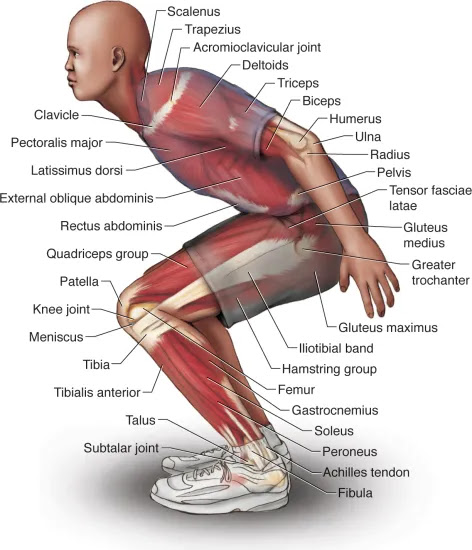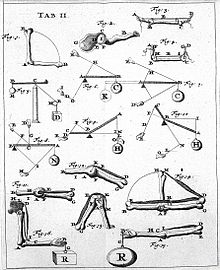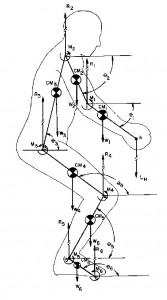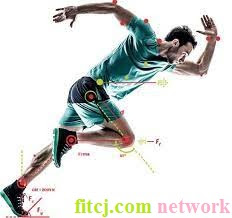The field of biophysics known as biomechanics (bio-mechanics)
uses the principles and techniques of mechanics to the quantitative analysis of
mechanical issues in living beings. Its studies cover everything from entire
organisms to systems and organs (including blood, body fluids, organs, bones,
etc.), from bird flying and fish swimming to flagella and cilia movement to the
movement of body fluids in plants. The three laws of energy, momentum, and mass
conservation as well as the constitutive equations characterising physical
attributes form the foundation of biomechanics. Research in biomechanics
focuses on mechanical issues that are connected to physiology and medicine. It
can be separated into motion biomechanics, biofluid mechanics, and biosolid
mechanics depending on the various research objects.
Bio-mechanics belongs to the branch of biophysics. The
research scope ranges from biological whole to systems and organs.
|
Table of Contents |
|
1. Origin 2. Development 3. Research status 4. Features 5. Categories
▪ Biosolid mechanics
▪ Biohydrodynamics
▪ Sports Biomechanics 6. Asian Studies
▪ Combined with traditional Chinese medicine 7. Description
▪ Biology major sub-field 8. Bibliography |
What is the Origin of Biomechanics?
Despite the fact that the name "biomechanics" wasn't coined until the 1960s, some of the topics it covers are age-old. Galileo, for instance, discovered a quantifiable relationship between pendulum length and period sometime about 1582. He then utilised the pendulum to gauge people's pulse rates and expressed the pulse rate as the pendulum length in time with the pulse.
Based on the continuity principle in fluid mechanics, the
British scientist W. Harvey theorised the existence of blood circulation in
1616.
Guvi's theory was supported by M. Malpighi in 1661, who discovered microcirculation in frog lungs while dissecting the amphibians. In "On the Movement of Animals," G. A. Borrell examines black fly, fish swimming, and the movement of the heart and intestines.
L. Euler wrote a
treatise on wave propagation in arteries in 1775. h. Lamb's 1898 prediction of
the presence of high-frequency waves in arteries has now been confirmed.
Horses' arterial blood pressure was recorded by British physiologist S. Hales, who was looking for a link between blood pressure and bleeding. He described how the heart's synchronised flow becomes a continuous flow in the blood arteries. He proposed the idea of peripheral resistance in blood flow and accurately noted that the small blood arteries are where the majority of this resistance is found.
The link between pressure drop, flow, and resistance during blood flow was established by J.-L.-M. Poiseuille.
The functioning of the heart is described by O. Frank. The equilibrium of water in the human body was elucidated by E. H. Starling, who also put out the law of mass transfer across membranes.
Due to his work on the mechanics of microcirculation, A. Kroger received the 1920 Nobel Prize.
A.V. Hill received the Nobel Prize in 1922 for his work on
muscle mechanics, which laid the foundation for the systematic study of
biomechanics that began in the 1960s.
Development of Bio-mechanics
Biology and mechanics support and advance one another in the progress of science. Based on the fluid mechanics principle of continuity, Harvey logically established the presence of blood circulation in 1615. Marpiji later proved this theory in 1661 when he discovered the microvessels in frog lungs.
In material mechanics, Young's modulus is a well-known term. The establishment of the elastic mechanics hypothesis of vocal cord pronunciation is presented.
The experimental foundation for Poisson's theorem, which describes the laminar motion of straight circular tubes in fluid dynamics, is the measurement of dog aortic blood pressure.
Hales measured the horses' venous blood pressure to determine their blood pressure The idea of peripheral resistance was presented in regard to blood loss, and it was noted that the resistance was mostly caused by the tissue's microvessels.
Starling postulated the transmission law of chemicals through membranes, while Frank proposed the hydrodynamic theory of the heart.
Crowe Hill twice received the Nobel Prize in Physiology or Medicine (1920, 1922) for his contributions to the mechanics of microcirculation and muscle.
Biomechanics had developed into a complete academic field by the 1960s.
What is the Research Status of Bio-mechanics?
Early in the 1960s, a team of engineering scientists and physiologists worked together to perform in-depth studies on problems in biology, physiology, and medicine using engineering viewpoints and techniques.
Some of these areas of study have evolved over time into distinct subfields of biomechanics, such as biorheology, which focuses on the mechanical characteristics of biological materials.
Muscles are a distinct category, and it generally divides biological materials into body fluids, hard tissues, and soft tissues.
Blood is the primary subject of research in body fluids, with the main goals being to better understand the viscosity of blood and the variables that affect it (such as tube diameter, formed components, and red blood cells), the precise volume distribution of red blood cells in the branch pipes, and the mechanical characteristics of red blood cells.
Red blood cell interactions, the function of red blood cells within the tube wall, etc. Studying the rheological characteristics of soft tissue is crucial in order to determine its constitutive relationship, which not only serves as the foundation for further examination of its mechanical issues but also has clinical implications. In addition to examining the rheological characteristics of hard tissue, extensive research has been done on the connection between stress and bone formation.
Long-term
studies have focused on the dynamics of several systems, particularly the
circulatory and respiratory systems.
Blood
flow in the heart, arteries, microvascular beds, and veins, as well as
mechanical issues with the heart and heart valves, are the main subjects of
research in the field of circulatory system dynamics. The creation and
progression of atherosclerosis are thought to be related to the local flow
regime, thus in addition to studying the flow in its piping system, this
research concentrates on the analysis of local flow regimes, such as flow
regimes at tube bends, tube forks, and stagnation places.
The primary focus of research on respiratory system dynamics is the movement of gas and blood during breathing, as well as the exchange of gas between Qi and blood.
All of these studies, such as those on the rheological characteristics and kinetics of biomaterials, not only advance our knowledge of human physiological fluid processes but also offer a solid scientific foundation for the development of artificial organs. The movement of plant fluids is another subject of biomechanics research. (see Flow in Plants).
Another area of biomechanics research is how the environment affects physiology. It is commonly recognised that oxygen has a significant impact on how organisms evolve.
In an oxygen-rich environment, organisms develop more quickly while in an oxygen-deficient one, the opposite is true. The environment has an effect, even in the short term.
Studies have demonstrated that young mice can survive under the wall of pulmonary arterioles with a diameter of 15 to 30 microns in an environment with 10% oxygen and a pressure of one atmosphere (1 atmosphere = 101 325 Pa).
There will be a lot of fibroblasts present. The fibroblasts will change into ordinary smooth muscle cells if it continues for 4 to 7 days, which will surely have an impact on the blood flow in the pulmonary circulation.
Another illustration is a person moving quickly; the blood's inertia will change dramatically in this situation, and the dangling organ will move away from its initial position, altering the blood's flow condition throughout the body.
The ideal form factor is frequently taken into account while designing equipment for water navigation. Best method of movement and propulsion.
Natural selection has made immortal species with these advantages more likely to persist and stray, and observing how some aquatic creatures migrate can provide some knowledge that is worthy of reference. For instance, a dolphin is a higher animal with an effective propulsion system and a good shape. In particular, its two-layered skin, which is loaded with adipose tissue and elastic fibres, offers unique drag-reducing capabilities. Due to its skin's great sensitivity to pressure gradients in the boundary layer and ability to make the proper elastic deformation to lower the reverse pressure gradient, it can maintain the laminar boundary layer condition even when swimming quickly. So, when swimming at high speed, the
epidermis is very sensitive to the pressure gradient in the boundary layer.
Wave-like motion can be generated to suppress the appearance of turbulence.
Another example is that the movement of ciliates is achieved
through the special movement of cilia, and the movement of this low-level
creature is also maintained in the human respiratory tract, that is, the use of
cilia to expel some foreign bodies in the respiratory tract.
In conclusion, the significance of studying biological motion
in nature is obvious.
What are the Features of Bio-mechanics?
The fact that live creatures are the subject of
study distinguishes biomechanics from other fields of mechanics most
significantly. Consequently, the setting in which the experimental individuals
are situated is crucial when addressing biomechanical issues. There are
typically in vivo and in vitro points used as experimental objects, and the
outcomes of the investigations differ accordingly.
Biological materials that are in a living state, or in their native condition, are typically under stress. The so-called free state, however, differs from the in-body condition once one has been set free. For instance, the lungs will shrink after being isolated and the length of the blood arteries will be greatly reduced.
In vivo experiments are divided into 2 situations:
- Anesthesia
- Non-anesthesia
As for the in vitro experiment, after the object is freed,
the experiment can be carried out according to the requirements in the overall
orthotopic position, or further processed into a test piece for the experiment.
Different experimental conditions and processing conditions
have a great influence on the experimental results. This is the characteristic
of biomechanical research.
What are the Categories of Biomechanics?
Biosolid Mechanics
Biosolid mechanics is the study of mechanical problems
related to biological tissues and organs using the basic theories and methods
of material mechanics, elastic-plastic theory, and fracture mechanics.
The strength theory of compression, tension, and fracture of human and animal bones, as well as their state characteristics, can be used to the common material mechanics formulas in the approximation analysis. But mechanically and morphologically, bones are anisotropic.
Since the 1970s, numerous theoretical and practical studies on the mechanical properties of bones have been conducted, including the combined rod hypothesis, the two-phase hypothesis, etc. Bone mechanics research has also made use of detection techniques like the finite element method, fracture mechanics, stress sleeve method, and pre-measurement elastic method.
Since bone is a composite material, its strength depends on both the substance's composition and the bone's internal structure.
Collagen fibres and inorganic crystals combine to form bone.
The bone plate is composed of longitudinal fibers and annular
fibers.
The inorganic crystals in the bone greatly improve the
strength of the bone.
It reflects the functional adaptability of bone to withstand
the maximum external force with the least structural material.
Both wood and insect skin are composite materials composed of
fibers embedded in other materials, which have similar mechanical properties to
fiberglass reinforced plastics composed of very fine glass fibers embedded in
synthetic resin.
Animals and plants are high polymers composed of
polysaccharides, protein lipids, etc.
The mechanical properties of proteins and polysaccharides can
be obtained by applying the polymer theory of rubber and plastics.
The knowledge of viscoelasticity, elastic deformation and
elastic modulus can be used not only for proteins composed of amino acids, but
also for analyzing the mechanical properties of related cells. Such as the
force of microfilaments during cell division, the working mode and working
principle of myofilaments, and the mechanical properties of cell membranes.
The study of bone tissue in biosolid mechanics dates back to the 19th century, and many scientists continued to work on the subject up until Wollf's famous Wollf's Law was put forth at the turn of the century. According to him, bone tissue is a self-optimizing tissue that will gradually change its shape in response to changes in external load to achieve the ideal condition. Since then, a great deal of research has been conducted, and on the basis of this law, numerous theories and mathematical models have been put forth. S.C. Cowin, D.R. Carter, and Husikes are some of the more well-known teachers. Professor Zhu Xinghua of Jilin University has also produced a significant amount of work in China.
Biofluid Mechanics
Bio-fluid mechanics is the study of mechanical problems
related to hydrodynamics, aerodynamics, boundary layer theory and rheology in
the biological cardiovascular system, digestive and respiratory system, urinary
system, endocrine, swimming, and flight.
The flow of blood in humans and animals and the transport of
plant body fluids are similar to the flow patterns of laminar flow, turbulent
flow, seepage and two-phase flow in fluid mechanics.
When analyzing hemodynamic properties, blood can be regarded
as a homogeneous fluid when it flows in large vessels.
In the course of a microcirculation examination, blood can be viewed as a two-phase fluid because the diameter of microvessels is equal to the diameter of red blood cells. Naturally, the non-Newtonian characteristics of blood are more noticeable the thinner the blood arteries are.
Laminar flow makes up the majority of blood flow in the human body, whereas turbulent flow is more likely to occur in areas where blood flows swiftly or where blood arteries are particularly thick.
Blood travelling through the aorta at its maximum velocity is hardly laminar and frequently becomes turbulent. The urethra's urine flow is frequently turbulent. Seepage is a term used to describe the exchange of materials through the capillary wall.
In the inflow such as blood flow, the blood flow is
fluctuating due to the pulsation of the heart, and the flow boundary is not
fixed due to the elasticity of the blood vessels. Therefore, the flow state of
blood in the body is more complicated.
Fluid mechanics expertise is also applied to the study of animal swimming for outflow. For instance, a fish's body is sleek, flexible, and can move forward by creating waves. The water tunnel experiment demonstrates that the fish's swimming causes a huge velocity gradient in the fluid boundary layer, which increases the force needed to overcome the fluid's viscous resistance. Small organisms and single cells can swim, which is another issue with outflow. The movement of the cell is caused by the fluid on the cell surface being pushed by the undulations of the flagella and the cilia. Sperm swim with flagella, the inertia of water is negligible, and
its hydrodynamic force is proportional to the relative swimming speed of sperm.
The resistance of protozoa in liquid can be calculated
according to the resistance formula (Stokes' law) of small particles in the
flow field.
In
addition, the principles and methods of aerodynamics are often used to study
animal flight.
Zero
lift power and induced power are the two components that make up an aircraft's
and an animal's flight power. The former is employed to get beyond the boundary
layer's air's viscous barrier. In order to generate a lift force equivalent to
the weight of the aircraft or flying creature, the latter is employed to
accelerate the air downward.
In
the same way that glider flaps may be adjusted, birds can change the glide
angle by flapping their wings back and forth in the air.
Studies of the flight characteristics of flying animals, like vultures and bats, whose gliding performance is strikingly similar to that of model gliders, have been conducted in wind tunnels.
Sports Biomechanics
Sports biomechanics is a discipline that combines the basic
principles of statics, kinematics and dynamics with anatomy and physiology to
study human movement. Using the principles and methods of theoretical mechanics
to study biology is a relatively early and in-depth field.
In human motion, the basic principles and equations of
laminar dynamics and dynamics are used to analyze and calculate the extreme
abilities of athletes in various sports such as running, jumping, and throwing.
The results are very similar to the records of the Olympic Games. In trauma
biomechanics, the finite element method is applied from a dynamic point of view
to calculate the frequency response of the head and neck under impact and
establish a trauma model, thereby improving the protection of the head and neck
and speeding up the treatment of trauma.
The dynamics of various organs and systems of the human body,
especially the heart-circulatory system and the lung-respiratory system, the
thermodynamic balance between biological systems and the environment, and
specific functions are also current research hotspots.
The study of biomechanics not only involves medicine and
sports, but also has penetrated into the relevant aspects of traffic safety,
aerospace and military science.
What are some Asian Studies on Biomechanics?
Bio-mechanics Combined with Traditional Chinese Medicine
Traditional Chinese medicine and biomechanics studies are merged to a significant extent in China. As a result, in the study of skeletal mechanics, pulse wave, non-destructive testing, massage, qigong, biological soft tissue, and other projects, it has developed its own features.
Before determining the mechanical properties of
tissues or materials, determining the constitutive equation, deriving the
primary differential equations and integral equations, determining the boundary
conditions, and solving them, biomechanical research must first comprehend the
geometrical characteristics of biological materials.
Physiological tests are necessary to validate
the answer to the aforementioned boundary problem.
If required, a different mathematical model should be created to address the issue in order to ensure that the theory and the experiment are coherent.
Secondly, the biological materials used as experimental objects can be divided into in vivo and in vitro.
In vivo biological materials
are generally in a stressed state (such as blood vessels, muscles), and once
freed, they are in a free state, that is, a non-physiological state (such as
blood vessels and muscles, once free, they will contract and shorten
significantly). The experimental results of the two state materials are quite
different.
Description of Biomechanics
The study of biomechanics should be carried out from the 2 major aspects of mechanics, histology, physiology, and medicine at the same
time, that is, to link the macro-mechanical properties with the micro-organism
structure. Therefore, multi-disciplinary joint research or researchers are
required to have multi-disciplinary knowledge.
Major Sub-fields of Biology
|
Anatomy |
Astrobiology |
Biochemistry |
Biogeography |
|
Biomechanics |
Biophysics |
Biostatistics |
Botany |
|
Cell Biology |
Cell Microbiology |
Chronobiology |
Conservation biology |
|
Developmental biology |
Ecology |
Epidemiology |
Epigenetics |
|
Evolutionary Biology |
Genetics |
Genomics |
Histology |
|
Human biology |
Immunology |
Marine biology |
Biomathematics |
|
Microbiology |
Molecular biology |
Mycology |
Neuroscience |
|
Nutrition |
Origin of life |
Paleontology |
Parasitology |
|
Pathology |
Pharmacology |
Physiology |
Quantum biology |
|
Systems Biology |
Taxonomy |
Toxicology |
Zoology |
Mechanics
|
Classical mechanics |
Branch discipline ▪statics ▪dynamics
▪kinematics ▪engineering mechanics ▪celestial mechanics ▪Continuum Mechanics
▪Statistical Mechanics ▪Newtonian Mechanics ▪Analytical Mechanics ▪Structural
Mechanics ▪Biomechanics ▪Material
Mechanics ▪Geomechanics ▪Soil Mechanics ▪statics ▪dynamics
▪kinematics ▪engineering mechanics ▪celestial mechanics ▪Continuum Mechanics
▪Statistical Mechanics ▪Newtonian Mechanics ▪Analytical Mechanics ▪Structural
Mechanics ▪Biomechanics ▪Material
Mechanics ▪Geomechanics ▪Soil Mechanics ▪statics ▪dynamics
▪kinematics ▪engineering mechanics ▪celestial mechanics ▪Continuum Mechanics
▪Statistical Mechanics ▪Newtonian Mechanics ▪Analytical Mechanics ▪Structural
Mechanics ▪Biomechanics ▪Material
Mechanics ▪Geomechanics ▪Soil Mechanics Branch discipline ▪Statics ▪Dynamics
▪Kinematics ▪Engineering mechanics ▪Celestial mechanics ▪Continuum Mechanics
▪Statistical Mechanics ▪Newtonian Mechanics ▪Analytical Mechanics ▪Structural
Mechanics ▪Biomechanics ▪Material
Mechanics ▪Geomechanics ▪Soil Mechanics ▪Statics ▪Dynamics
▪Kinematics ▪Engineering mechanics ▪Celestial mechanics ▪Continuum Mechanics
▪Statistical Mechanics ▪Newtonian Mechanics ▪Analytical Mechanics ▪Structural
Mechanics ▪Biomechanics ▪Material
Mechanics ▪Geomechanics ▪Soil Mechanics ▪statics ▪dynamics
▪kinematics ▪engineering mechanics ▪celestial mechanics ▪Continuum Mechanics
▪Statistical Mechanics ▪Newtonian Mechanics ▪Analytical Mechanics ▪Structural
Mechanics ▪Biomechanics ▪Material
Mechanics ▪Geomechanics ▪Soil Mechanics Important theory ▪Newton's law of motion
▪Hooke's law ▪Law of universal gravitation ▪Eulerian equation
▪Hamilton's principle ▪Lagrange equation ▪Least action principle ▪Newton's law of motion
▪Hooke's law ▪Law of universal gravitation ▪Eulerian equation
▪Hamilton's principle ▪Lagrange equation ▪Least action principle ▪Newton's law of motion
▪Hooke's law ▪Law of universal gravitation ▪Eulerian equation
▪Hamilton's principle ▪Lagrange equation ▪Least action principle Important theory ▪Newton's law of motion
▪Hooke's law ▪Law of universal gravitation ▪Eulerian equation
▪Hamilton's principle ▪Lagrange equation ▪Least action principle ▪Newton's law of motion
▪Hooke's law ▪Law of universal gravitation ▪Eulerian equation
▪Hamilton's principle ▪Lagrange equation ▪Least action principle ▪Newton's law of motion
▪Hooke's law ▪Law of universal gravitation ▪Eulerian equation
▪Hamilton's principle ▪Lagrange equation ▪Least action principle |
|
Quantum mechanics |
Derivatives ▪Atomic physics ▪Solid
state physics ▪Nuclear physics ▪Particle physics ▪Atomic physics ▪Solid
state physics ▪Nuclear physics ▪Particle physics ▪Atomic physics ▪Solid
state physics ▪Nuclear physics ▪Particle physics Derivatives ▪Atomic physics ▪Solid
state physics ▪Nuclear physics ▪Particle physics ▪Atomic physics ▪Solid
state physics ▪Nuclear physics ▪Particle physics ▪Atomic physics ▪Solid
state physics ▪Nuclear physics ▪Particle physics Important theory ▪Pauli exclusion
principle ▪Ehrenfest theorem ▪State superposition principle ▪uncertainty
principle ▪Blackbody radiation ▪Atomic
structure ▪Photoelectric effect ▪Wave-particle duality ▪Pauli exclusion
principle ▪Ehrenfest theorem ▪State superposition principle ▪uncertainty
principle ▪Blackbody radiation
▪Atomic structure ▪Photoelectric effect ▪Wave-particle duality ▪Pauli exclusion
principle ▪Ehrenfest theorem ▪State superposition principle ▪uncertainty
principle ▪Blackbody radiation
▪Atomic structure ▪Photoelectric effect ▪Wave-particle duality Important theory ▪Pauli exclusion
principle ▪Ehrenfest theorem ▪State superposition principle ▪uncertainty
principle ▪Blackbody radiation
▪Atomic structure ▪Photoelectric effect ▪Wave-particle duality ▪Pauli exclusion
principle ▪Ehrenfest theorem ▪State superposition principle ▪uncertainty
principle ▪Blackbody radiation
▪Atomic structure ▪Photoelectric effect ▪Wave-particle duality ▪Pauli exclusion
principle ▪Ehrenfest theorem ▪State superposition principle ▪uncertainty
principle ▪Blackbody radiation
▪Atomic structure ▪Photoelectric effect ▪Wave-particle duality |
Author's Bio
Education: MBBS, MD
Occupation: Medical Doctor
Specialization: Community Medicine, General Surgery, Natural Treatment
Experience: 18 Years as a Medical Practitioner










Comments
Post a Comment